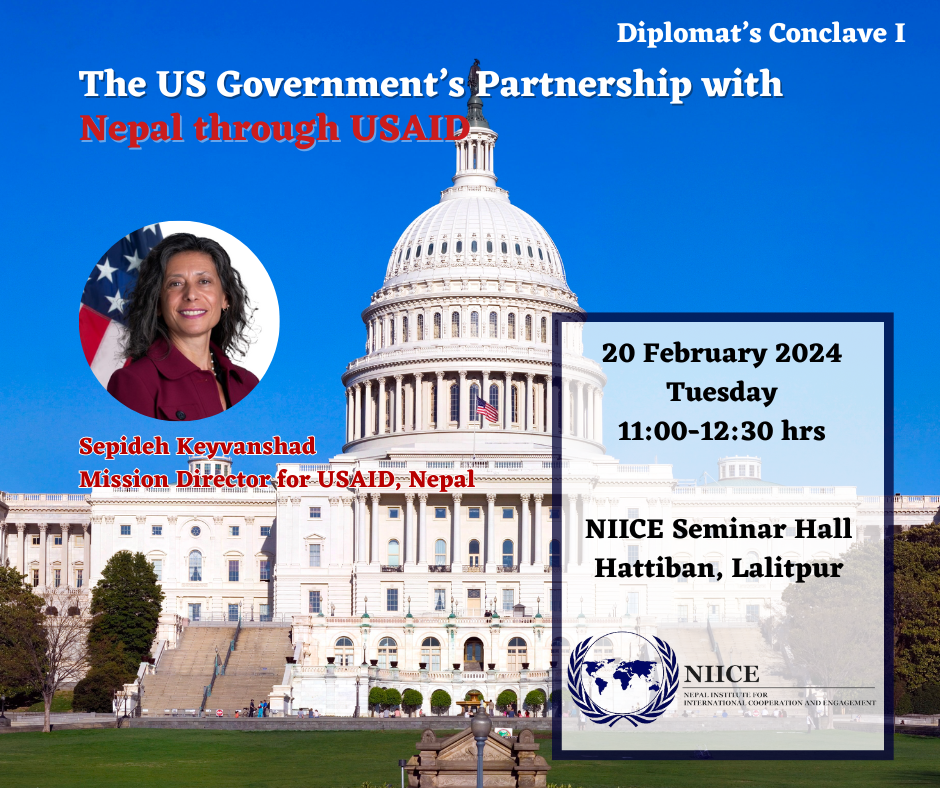
The US Government’s Partnership with Nepal through USAID
Event Report
On February 20th, the Nepal Institute for International Cooperation and Engagement (NIICE) hosted the Diplomatic Conclave I, focused on “The US Government’s Partnership with Nepal through USAID.” Sepideh Keyvanshad, a Mission Director for USAID, Nepal, emphasised the relationship between the U.S. government and Nepal through USAID.
Sepideh began her speech by expressing excitement about being there in person and reflecting on how in-person events differed from virtual ones. She noted that it was a particularly fitting time to have this discussion, as she was nearing the end of her three-and-a-half-year tour in Nepal.
She highlighted the long-standing partnership between the US and Nepal, which spanned 76 years, with USAID’s involvement for 60 years. Initially focused on infrastructure, the relationship evolved into a more collaborative approach where Nepal took the lead in its development journey. Sepideh emphasised that USAID's role was now more about partnership, supporting Nepal’s priorities in areas like agriculture, tourism, health, and education.
The speech underscored the shift from direct donor assistance to strengthening systems and partnering with local communities. Localization was a key focus, with efforts to transfer more control and resources to local entities, including the government, which now led many development initiatives. Sepideh also discussed the challenges of ensuring inclusivity in development efforts, acknowledging the difficulty but emphasising USAID’s commitment to working closely with local communities to address their specific needs. The impact of COVID-19 on global health security was noted, with Nepal's strong vaccination efforts highlighted as a successful example of collaboration between the government and development partners.
During the Q&A session, she highlighted Nepal's ambitious efforts, including significant targets and the utilisation of hydroelectric resources. However, she emphasised the need to consider trade-offs, as climate change disproportionately affected vulnerable communities, worsening existing inequalities. As Nepal expanded its hydroelectric capacity, it faced the challenge of balancing environmental goals with the needs of communities that may need to adapt or relocate due to changing water flows. While progress was commendable, it was essential to ensure that climate initiatives did not further disadvantage those already affected by climate change. She noted that working in Nepal had been challenging, not because it was inherently difficult to work there, but because development is inherently difficult in every country, as demonstrated by her experiences in Russia, El Salvador, and Afghanistan. Key challenges included ensuring effective education with limited resources, providing healthcare access in remote areas, and encouraging private sector investment.
The most significant hurdle was the need for change in mindsets and behaviours, which often met with resistance. Development relied on understanding incentives and how individuals saw themselves within society. Within USAID, there was a commitment to localization—prioritising local leadership—which faced challenges due to long-established practices. Despite these difficulties, Sepideh emphasised that development was a valuable endeavour, worth the effort required to overcome obstacles. Addressing concerns about how USAID could support Nepal after its LDC graduation in 2026, Sepideh acknowledged worries about changing assistance, particularly regarding loans and interest rates. However, USAID emphasised that its support would remain consistent, focusing on grants rather than loans. Funding levels were determined by Congress and were not influenced by LDC status. Thus, USAID's methods and relationship with Nepal would continue unchanged after graduation.
In summary, Sepideh also noted the global context of media challenges but admitted limited knowledge about Nepal's specific media environment, suggesting that these issues required broader consideration on an international scale.

Recent Comments